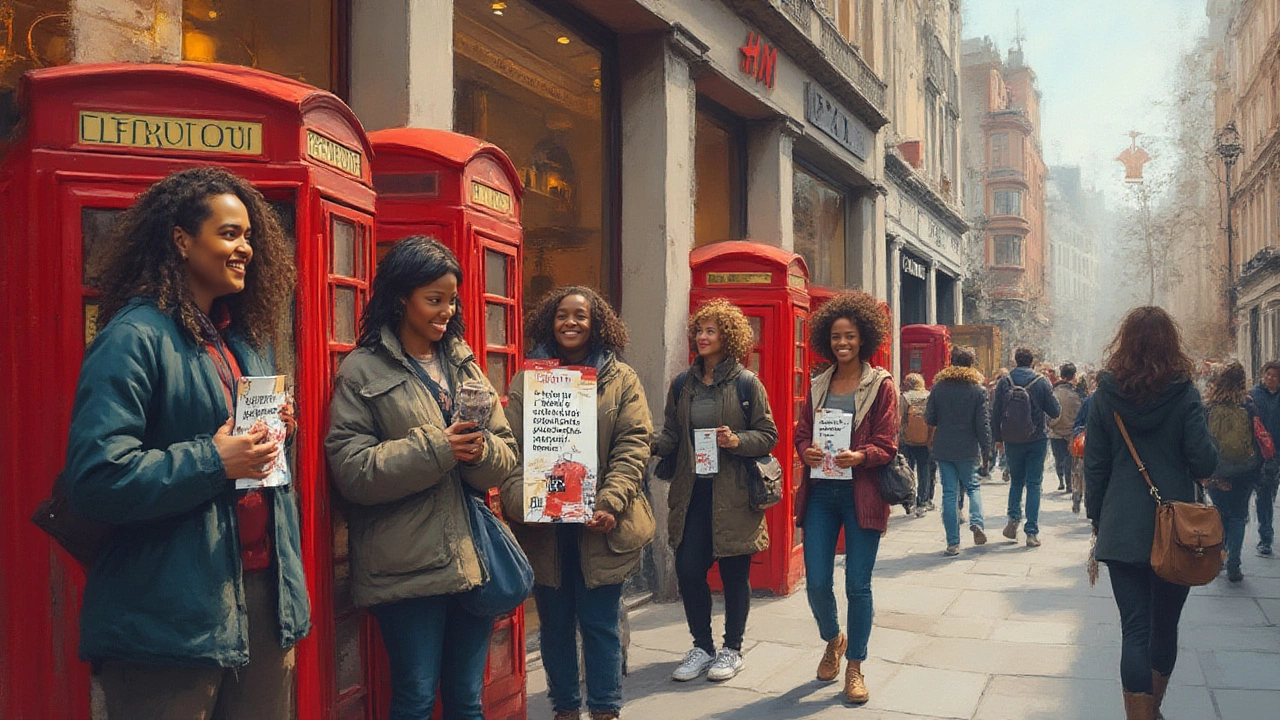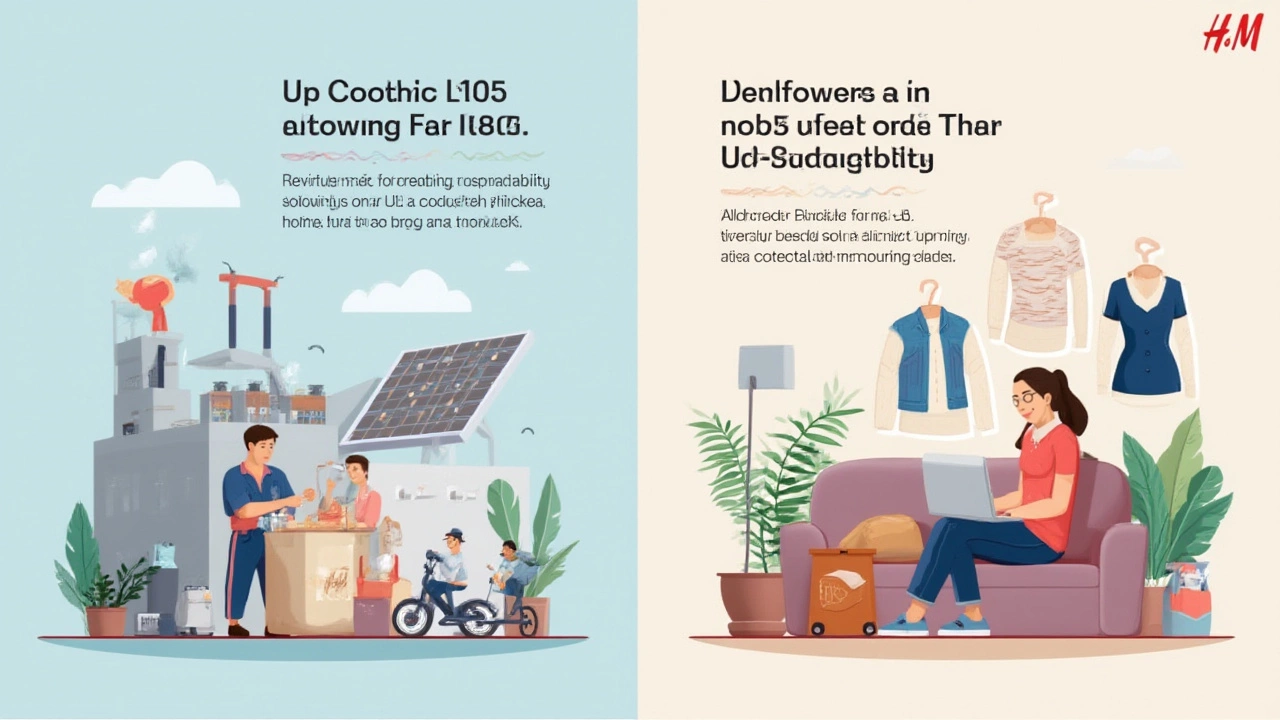Did you ever buy a £7 sundress and wonder who actually made it and how? People haven’t stopped asking about H&M’s long trail of sustainability promises, but the landscape’s changing fast. There was a time when the answer was simple: H&M was fast fashion. But here we are, in 2025, and their ethics and green claims spark wild debates on TikTok and Reddit every week. Is it still just greenwashing, or has H&M truly turned a corner?
The Real Story Behind H&M’s Ethical Claims
Walk into any H&M store these days, and you’ll spot signs for “Conscious Choice” jeans and “recycled cotton” sweatshirts. The company shouts about their eco-friendly collections and circular fashion plans. But what’s really happening behind the marketing haze?
H&M ranks among the world’s largest fashion retailers—with around 4,500 stores in 76 countries (as of late 2024). They move over three billion pieces of clothing every year. That scale is massive, and so is their impact, both good and bad. In 2013, after the deadly Rana Plaza collapse, H&M signed the Accord on Fire and Building Safety in Bangladesh. They promised more transparent supply chains and better working conditions. Sounds good, right?
Fast-forward to now, and they're pumping out glossy sustainability reports that claim they’re using 80% recycled or sustainable materials in their products. According to their 2024 Sustainability Disclosure, over 90% of their cotton comes from more sustainable sources. They’ve also pledged to be “climate positive” by 2040. Here’s where things get tricky: just last year, a court in Norway reprimanded H&M for making “misleading sustainability claims.” The EU actually started investigating whether their new “green” labels on clothing were too vague or just marketing spin.
Here’s a hard fact that almost never makes it onto the in-store leaflet: The modes of production haven’t slowed down. H&M dropped over 16 collections in 2024, with some weekly inventory resets. Fashion waste is still a massive problem. According to the Ellen MacArthur Foundation’s 2023 report, less than 1% of clothing globally is recycled into new clothes. H&M collects used garments in-store and touts a recycling program, but only a fraction actually gets reused—instead, much ends up exported to landfills in Africa and Southeast Asia.
H&M claims all their suppliers must meet the Higg Index standards for environmental and social responsibility. Since 2022, they have published their supplier list online—a big step for transparency, but not a guarantee the factories behind those lists pay living wages or offer safe workspaces. Clean Clothes Campaign, one of the most respected NGOs in this space, argues H&M’s “Fair Living Wage” roadmap has been far more aspirational than actual. In most cases, workers in Bangladesh and Cambodia still earn well below living wage levels.
"H&M has made important promises, but when workers sewing for their suppliers still can’t feed their children or keep them in school, something fundamental hasn’t changed.” – Clean Clothes Campaign, Annual Report 2024
So, is H&M finally ethical? The company has obviously shifted from its Wild West days and taken serious steps. But when you dig in, you find big gaps between ambition and day-to-day reality. If a label says “recycled” or “conscious,” double-check it on the H&M website using their transparency tool—they now share fibre content info and the factory name. Still, most “green” pieces only include 20–50% recycled or better fibre, with the remainder unchanged.
When shopping, don’t forget the context. H&M’s sustainable garments cost only a few pounds more than standard, but super cheap prices mean someone, somewhere, is paying—often not the company, but a garment worker or the planet.
| Claim | Reality (2025) |
|---|---|
| 90% sustainable cotton | Includes BCI cotton – not organic, less regulated |
| Sustainability labels | Often vague, under EU review |
| Ethical supply chain | Factory audits ongoing, but wage gaps persist |
| Garment recycling program | Less than 15% actually reused/recycled |
| "Climate positive" by 2040 | Ambitious, but depends on major operational changes |

What H&M Is Actually Doing for Sustainability and Workers
If you scroll through H&M’s corporate Instagram, it’s all upcycled patchwork, 100% organic tees, and diverse model lineups. But what moves are they really making?
Let’s break it down. First up—materials. H&M was ahead of many high-street rivals in pushing recycled polyester (sourced from plastic bottles and old clothes). By mid-2024, they hit about 65% recycled or organic fibres in new collections. The company joined the Ellen MacArthur Foundation to support a circular economy, creating “Take Care” pop-ins in some flagship locations, where you can repair, reuse, or refresh worn clothes. They rolled out a physical and online “Garment Collecting” program years ago, which now sits at more than 50,000 tonnes collected worldwide. The hard bit is turning that into new clothes (less than 1% of the fibre collected actually gets spun into H&M’s new lines, as circular technology remains limited).
About the factories: H&M doesn’t own them, but sources from almost 800 suppliers. They publish names and rough locations, including the factory name on the product tag. After major pressure from campaigners, their supplier code enforces safety inspections, bans child labor, and encourages minimum wage payments. Still, transparency is only step one—it doesn’t guarantee fair pay or conditions daily. A 2024 research project from Fashion Revolution pointed out that while fire safety improved, mental health support and overtime limits are still far from ideal, especially in lower-tier suppliers.
What about carbon? H&M pledged in 2019 to go climate positive by 2040, which means sucking more carbon from the atmosphere than they emit. They’ve started switching to renewable power for company-owned locations (about 90% now), but third-party manufacturers often still burn coal. Most of the company’s emissions—close to 70%—are generated in the textile production phase, before clothes ever hit Europe or North America. Reducing that will take stricter criteria for suppliers and slower collections, not more.
The other side of ethics is how fast fast fashion keeps churning out style after style. H&M’s “Made to Order” trial in 2024, where customers could personalize items made in small batches, was an interesting effort to slow production and cut waste. But it’s still a pilot. Meanwhile, clearance bins are filled with unsold jumpsuits and tank tops that will keep the waste issue alive.
H&M is also investing in innovations: they co-financed a textile-to-textile recycling tech startup and tried renting high-end garments at their Stockholm flagship. These ideas nudge the conversation beyond disposable fashion. But they’re still tiny compared to the main business model—rapid production and cheap prices.
Consumer insight: if ethics are your number one, go for clearly labelled 100% “organic,” “Fairtrade,” or “GOTS certified” items. To push change, use H&M’s online chat to ask about wages for a specific collection or message them on social media—it actually gives useful signals to their teams. There’s real power in public pressure. In 2023, H&M raised rates for two Bangladeshi suppliers after customers flagged pricing issues online. It’s slow, but it works.
- Check hangtags and product descriptions for specifics, not just “sustainable materials.”
- Use the Good On You app to compare H&M’s latest eco ratings.
- Join recycling programs, but remember the impact is still limited compared to simply buying less.
- For child-friendly options, H&M’s new 2025 regulation-compliant kidswear includes organic cotton basics at decent prices.
- If you spot “Conscious Choice,” look up the transparency info online to see real fibre %, not just marketing words.
Remember, H&M is still one of the only big fast fashion chains that publishes all factories and has a public garment collection scheme—you won’t find that level of info at most competitors, even Uniqlo or Zara.

Making Smart Choices: Can You Shop H&M Ethically?
If you’re navigating your own closet and minding your impact, what should you do about H&M? You don’t have to give up fast fashion all at once. Single-use shopping rarely leads to long-term change, for you or for the brands. It’s about knowing what’s behind the price tag and picking your battles.
First, if you shop at H&M, buy less and make it last. That does more for ethics than anything else. Opt for timeless cuts and avoid the “micro-trend” racks—those pieces end up in charity shop purgatory by winter. Picking ethical fashion doesn’t need to be all or nothing. Build your basics from the Conscious or organic lines, then mix in vintage and thrift store finds for the rest.
Every brand marketing “sustainability” is under the spotlight in 2025. Use this as leverage: if enough shoppers demand specific answers about fair wages and climate impact, companies like H&M have to change faster. If you want proof, look to Denmark’s 2024 “Green Claims” law. Now, companies must provide evidence for every eco claim or face fines. Other countries are expected to follow.
The easiest way to reduce fashion’s pressure on people and planet is to extend how long you keep each item. Use H&M’s mending stations (if you’re near a flagship), try their Garment Collecting box for worn-out tees, and store clothes properly to avoid early wear and tear. Avoid tumble-drying whenever you can, as it causes microplastics to shed from synthetic fabrics—wash cold and air dry when possible.
If you want to push H&M for more, vote with your wallet and your voice. Leave reviews, tag their social team, and ask about specifics for labour conditions and fibre sources. Pay a bit more for certified pieces, not just “sustainable” ones. Consider building a capsule wardrobe—fewer pieces, but higher quality—so you can cut the churn and save money, too.
Still worried about price? Access clothing swap groups or secondhand H&M items on apps like Vinted or Depop. This keeps garments out of landfill and is the lowest-impact option besides not buying at all. And hey, you might even spot last year’s “it” dress for less than half the price.
Here’s a tip people often miss: if you find a great H&M denim jacket or hoodie, take a close look at the care labels. If it’s made in Turkey, Portugal, or Morocco, those suppliers were hit with stricter audits this past year and have better scores on labour rights. Not perfect, but a bit better.
Ethics in fashion is always a moving beast. H&M isn’t there yet—but the debate, the data, and persistent public questions mean they can’t coast like they used to. Keep asking, keep checking, and keep pushing for better. Your shopping choices actually do move the needle.





